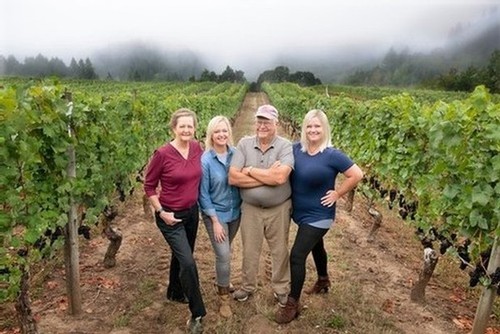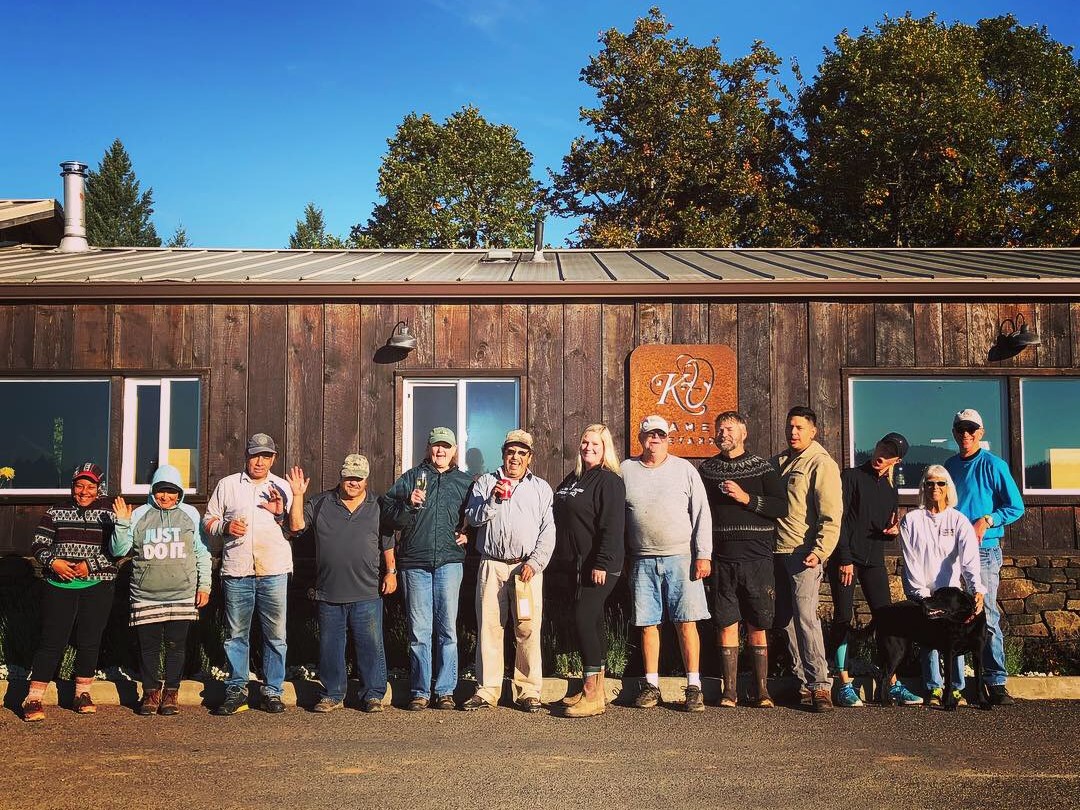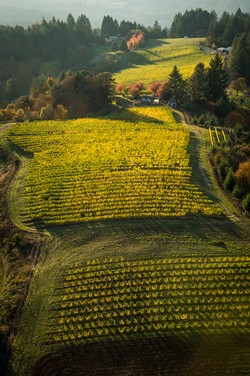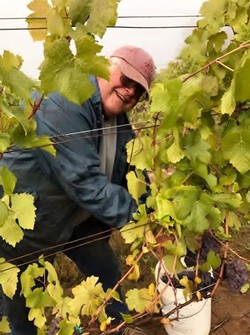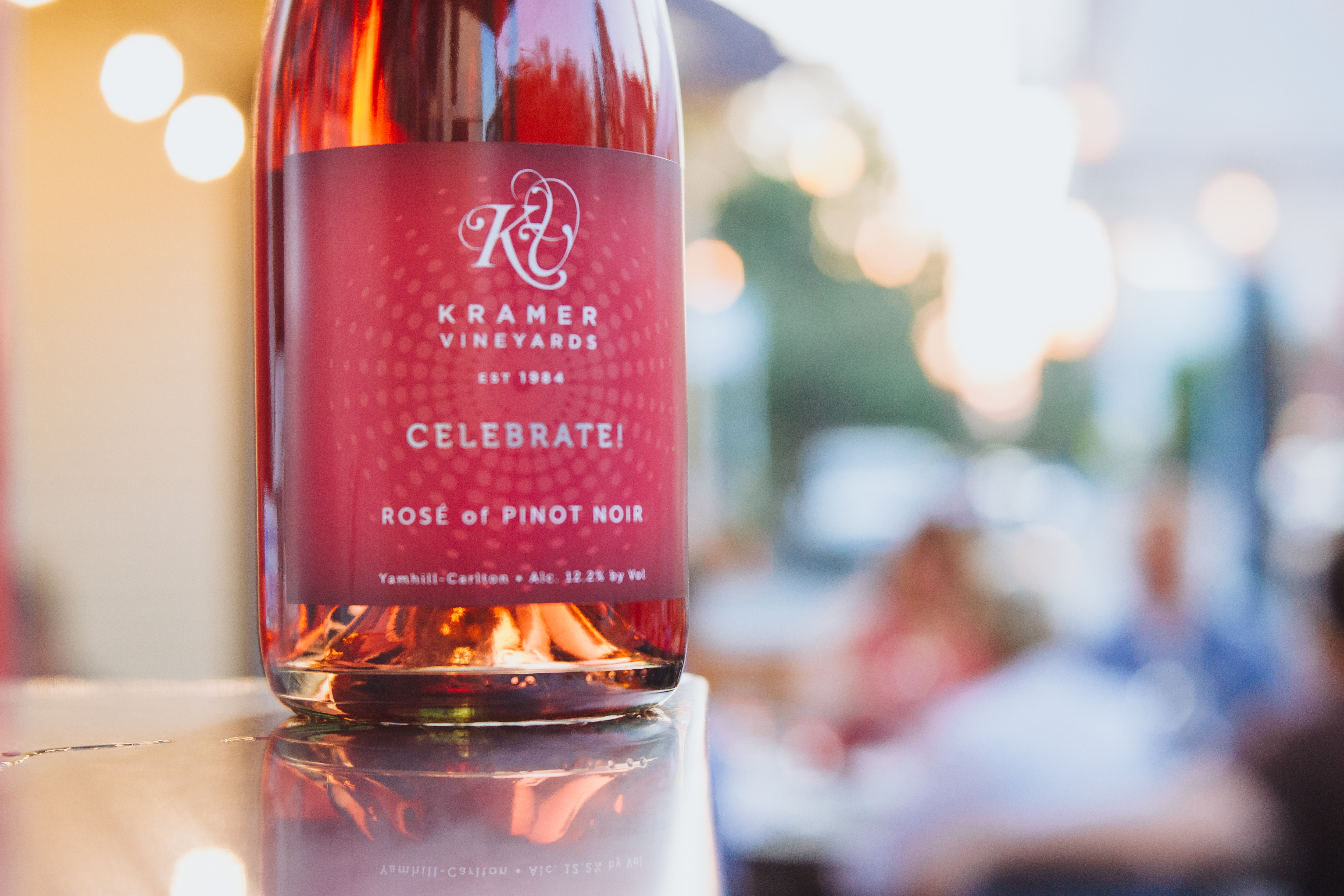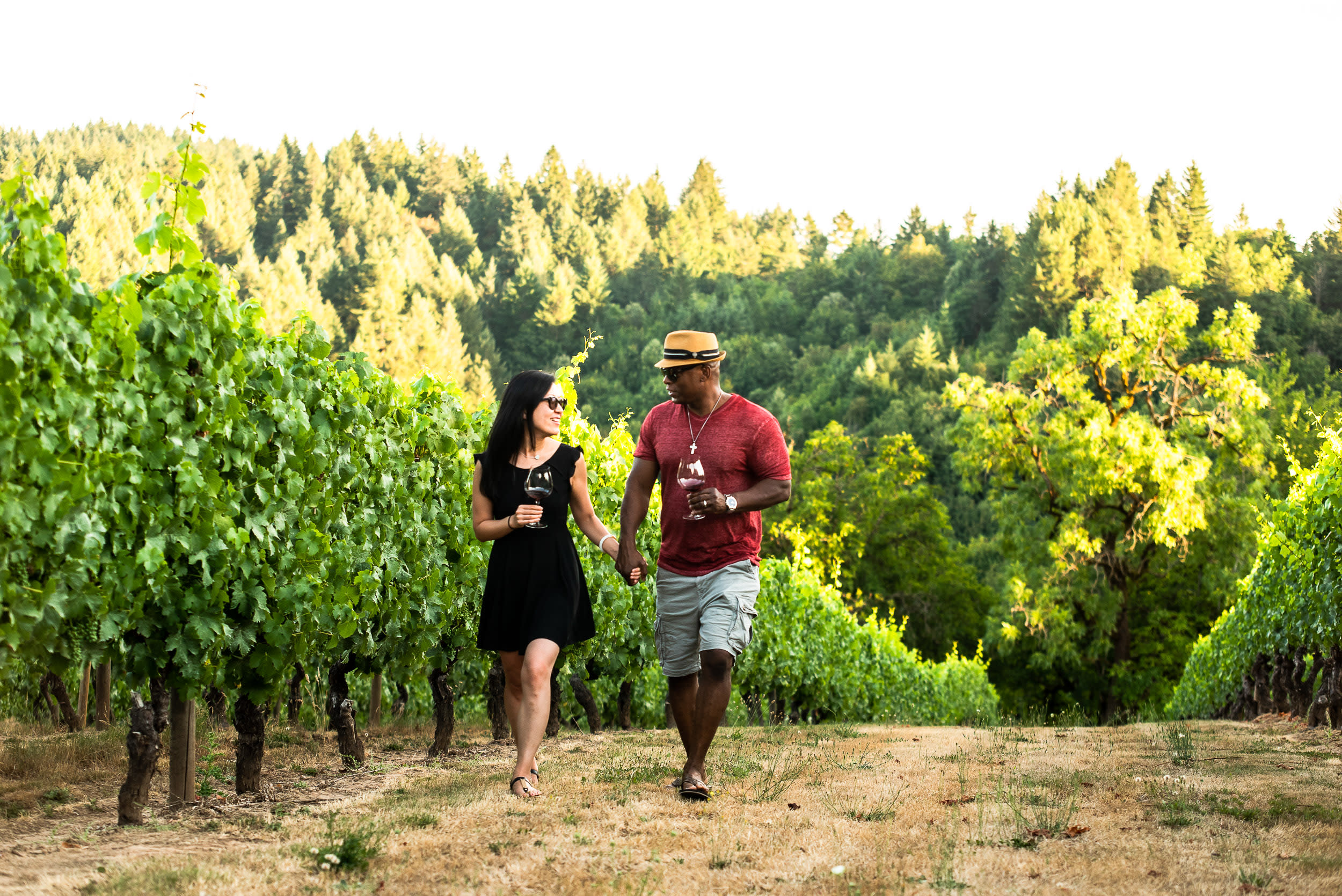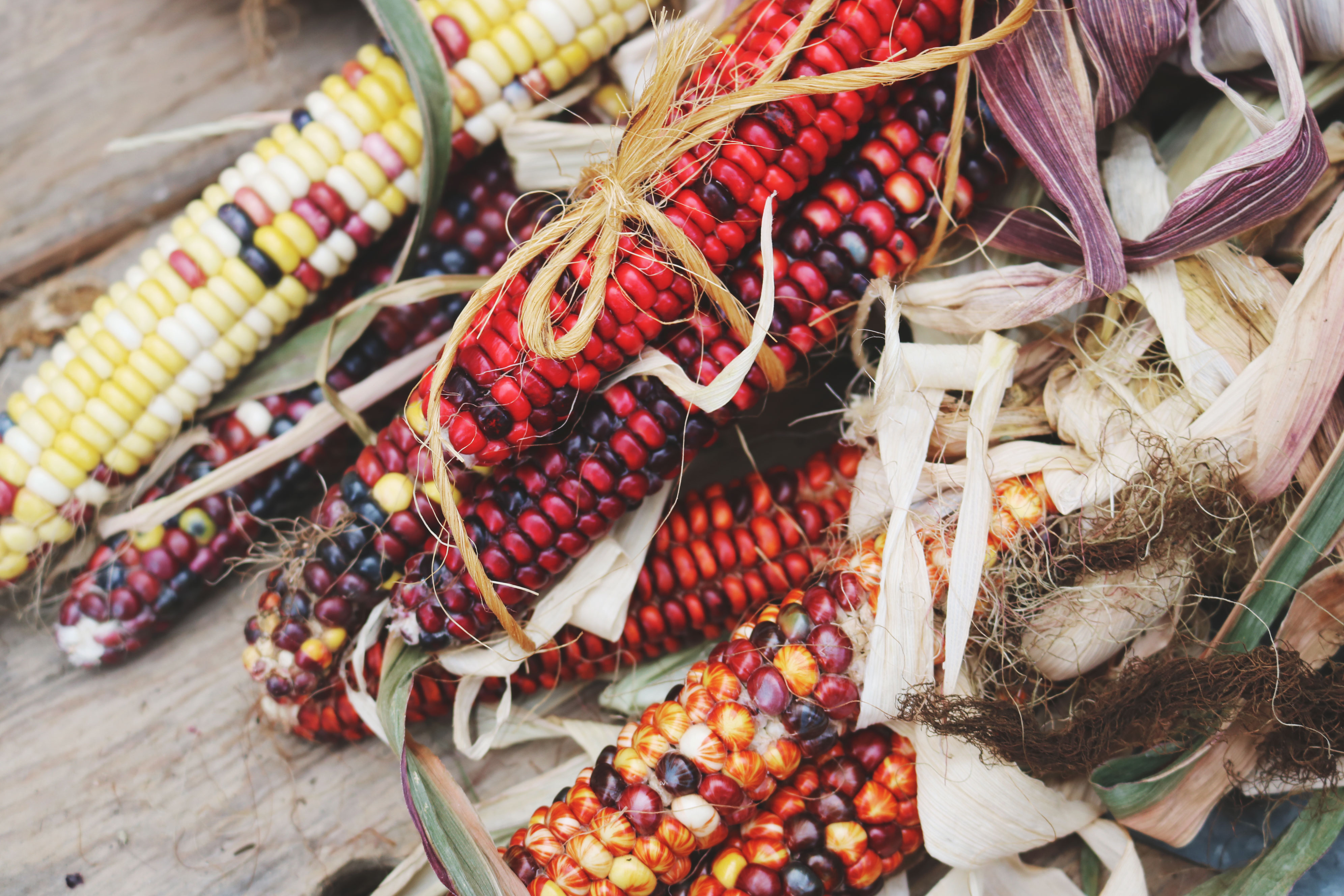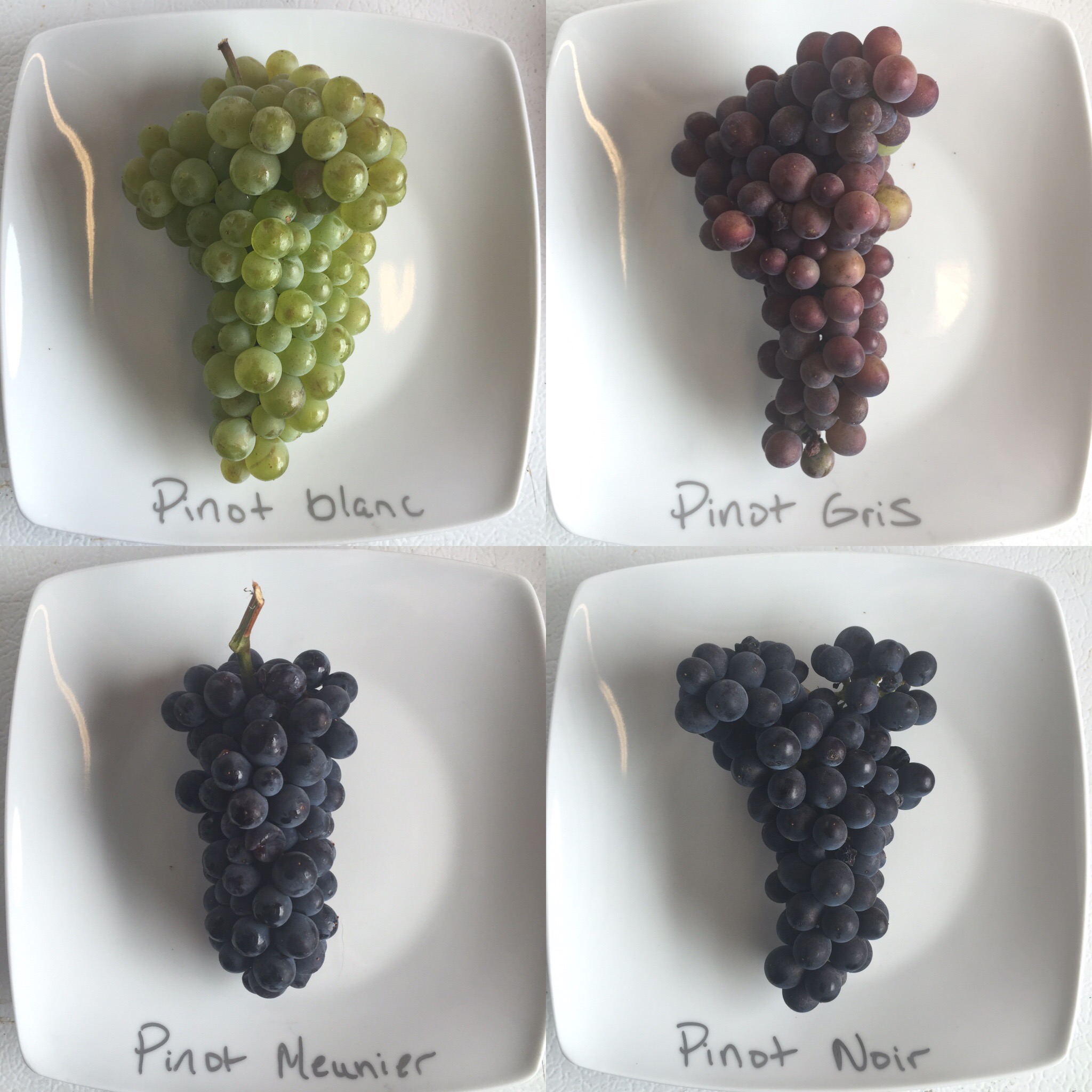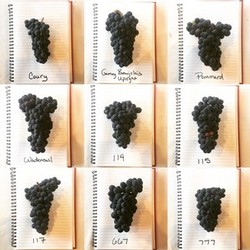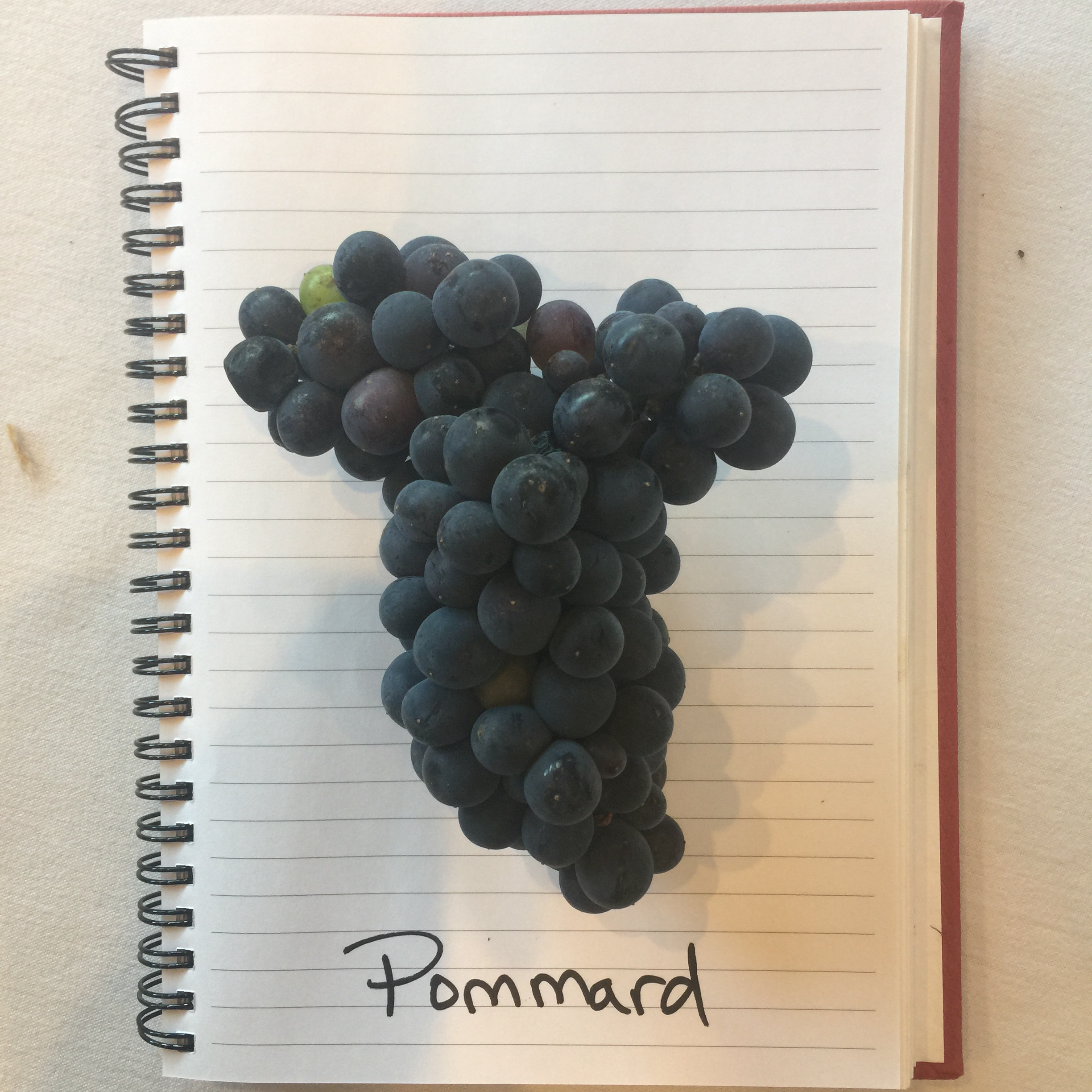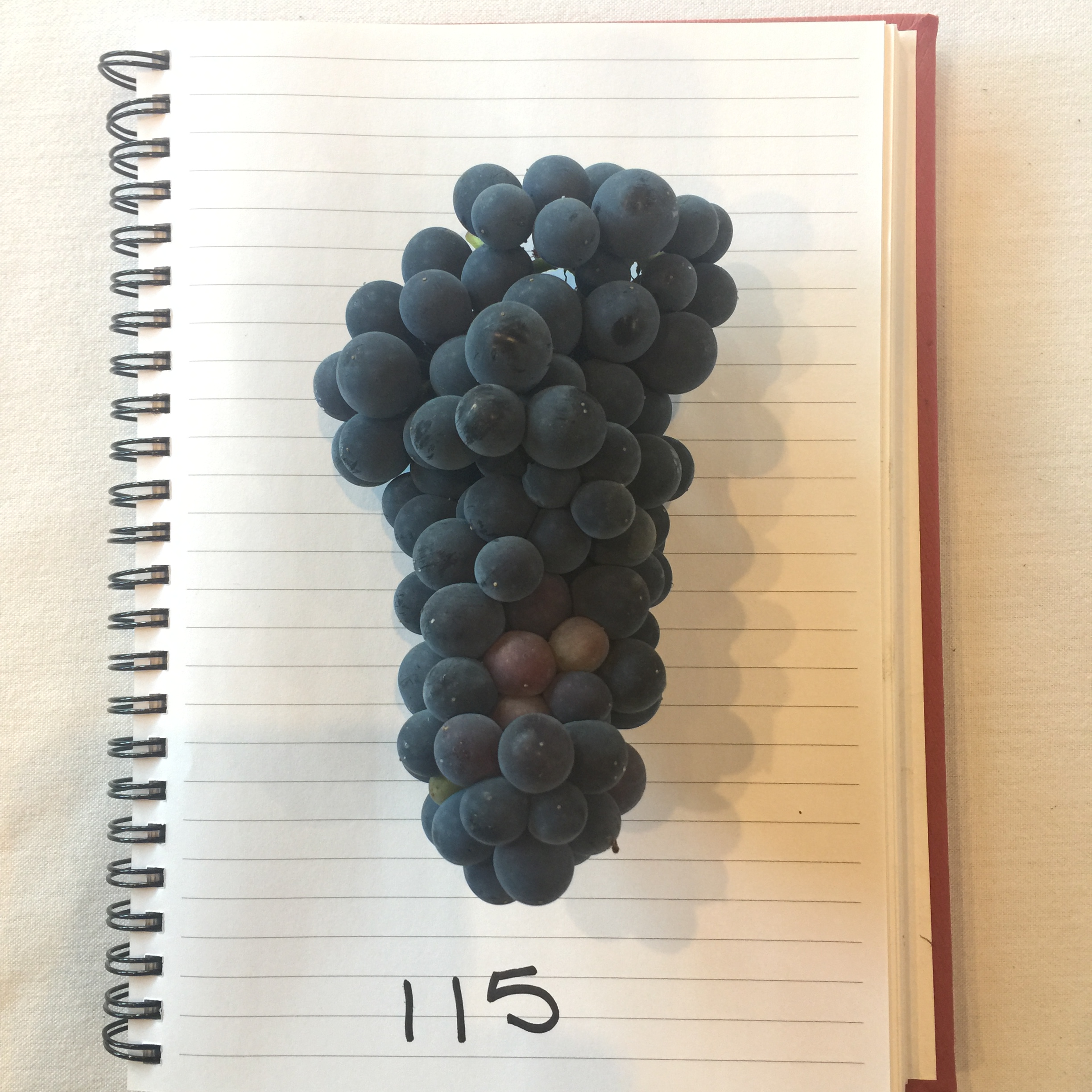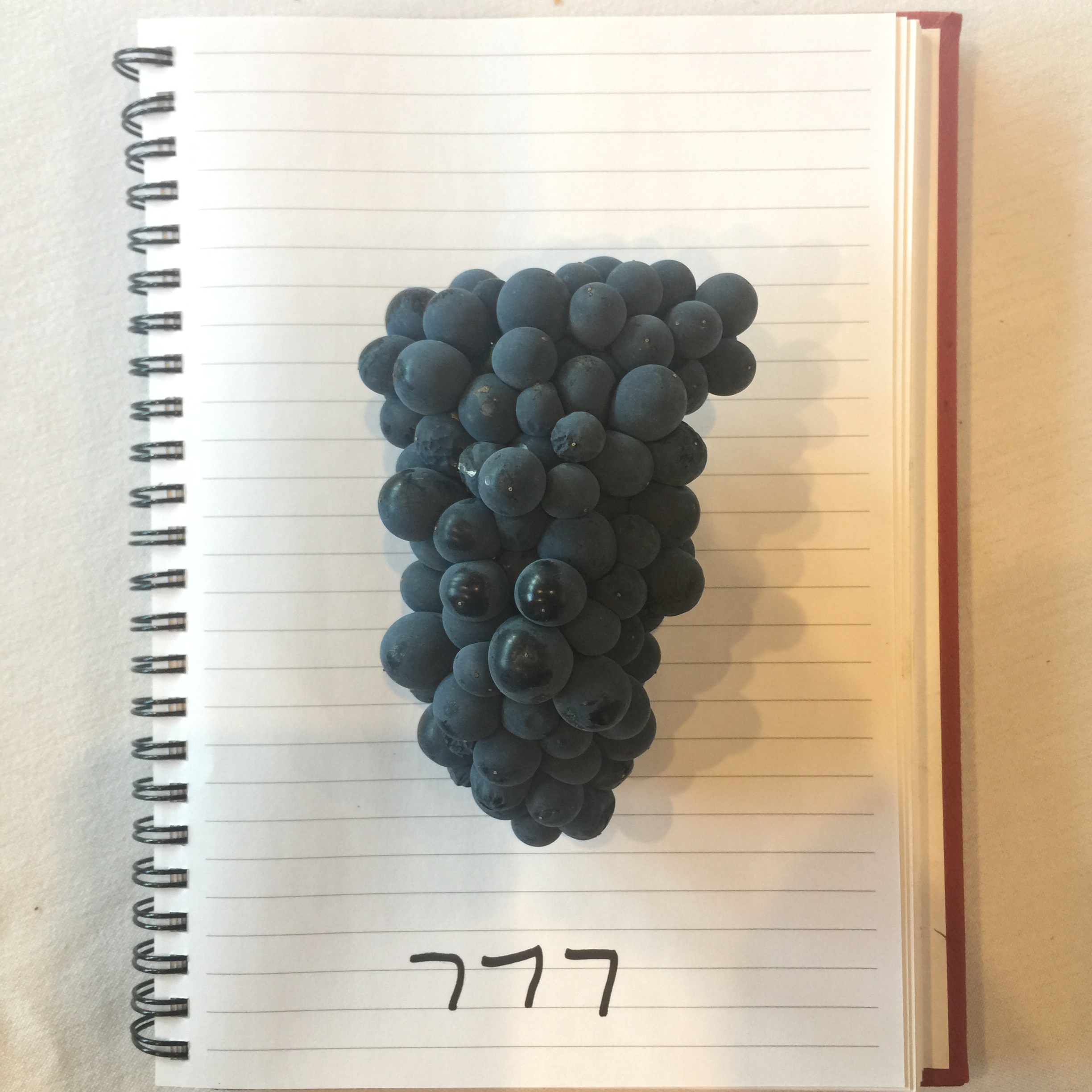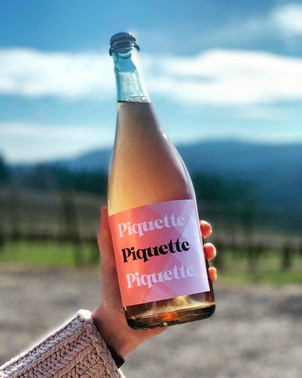🍇 Kramer Vineyards Blog: Discover Wine Tips, Stories, and More 🍷
Welcome to the Kramer Vineyards blog, your go-to resource for all things wine! From expert pairing tips and behind-the-scenes vineyard stories to seasonal inspiration, discover the artistry, history, and passion behind every bottle. Explore our latest articles and uncover new ways to enjoy exceptional wines.
Never Miss a Story!
Subscribe to the Kramer Vineyards newsletter for the latest wine tips, pairings, and stories.
Perfect Pairings for Oregon Pinot Noir: From Classics to Bold New Ideas
Oregon Pinot Noir is celebrated for its versatility, balancing bright fruit flavors, vibrant acidity, and earthy undertones. At Kramer Vineyards, we’ve crafted Pinot Noir that complements the flavors of the Pacific Northwest and beyond. Whether you love timeless pairings like buttery salmon and wild mushrooms or want to try bold ideas like char siu pork and lamb burgers, there’s a Pinot Noir pairing for every occasion. Let’s explore how this exceptional varietal can elevate your dining experience.
Classic Oregon Pinot Noir Pairings
Northwest Salmon
The rich, buttery flavors of salmon harmonize beautifully with Pinot Noir’s bright fruit notes and acidity. Salmon’s natural sweetness enhances the wine’s elegance, whether grilled, roasted, or smoked. For a lighter twist, pair salmon with our Pinot Noir Blanc, which accentuates the delicate flavors of the fish while balancing its richness.
Wild Mushrooms
Wild mushrooms like morels, chanterelles, and porcini are earthy and savory, perfectly complementing Pinot Noir’s nuanced character. The wine’s subtle earthy undertones complement the mushrooms’ depth, creating a symphony of flavors. Try pairing Pinot Noir with mushroom risotto, flatbreads, or a mushroom tart for a truly satisfying meal.
Duck and Quail
The richness of roasted duck or quail perfectly complements Pinot Noir’s medium body and red fruit notes. The wine’s acidity cuts through the meat's richness, balancing its flavors and enhancing the overall dining experience. This classic pairing highlights the versatility of Oregon Pinot Noir with game birds.
Hazelnuts, Marionberries, Tillamook Cheese, and Oregon Truffles
These quintessential Northwest ingredients showcase the region’s bounty while pairing beautifully with Pinot Noir:
- Hazelnuts: Their nuttiness complements Pinot Noir’s earthy profile, adding a satisfying crunch to salads or charcuterie boards.
- Marionberries: Sweet and tart, these berries elevate the wine’s fruit-forward character, especially in desserts.
- Tillamook Cheese: Rich, tangy flavors in Tillamook cheese pair seamlessly with Pinot Noir’s balanced acidity, making it a standout choice for cheese platters.
- Oregon Truffles: With their luxurious earthy aroma, truffles enhance the wine’s depth and complexity, creating a pairing fit for a special occasion.
Unconventional Pairings
Char Siu Pork with Five-Spice
The savory-sweet flavors of char siu pork, seasoned with five-spice, align beautifully with Pinot Noir’s earthy undertones and red fruit character. The wine’s acidity balances the richness of the pork, while the five-spice adds a touch of complexity without overwhelming the palate.
Beet and Goat Cheese Tart with Hazelnut Crust
Earthy beets and tangy goat cheese bring out Pinot Noir’s mineral and red fruit notes, while a hazelnut crust adds a rich, nutty complement to the wine’s smooth texture. This pairing is both visually stunning and flavorfully harmonious.
Collard Greens with Smoky Ham Hock
Every New Year’s, we enjoy a meal of collard greens, black-eyed peas, and cornbread—a tradition we love for its comforting flavors and sense of community. Slow-cooked collard greens highlight the smoky depth of a ham hock and pair beautifully with Pinot Noir. The wine’s balanced acidity and subtle tannins complement the greens’ hearty flavors while enhancing their earthy undertones. This pairing celebrates the versatility of Oregon Pinot Noir while honoring a meal deeply rooted in Southern-inspired cuisine.
Lamb Burger with Basil Aioli and Brie
A lamb burger brings robust, savory flavors that beautifully balance Pinot Noir’s acidity and fruit-forward notes. Topped with creamy brie and herbaceous basil aioli, this pairing adds layers of complexity while staying true to the wine’s elegance.
Korean Japchae (Glass Noodles with Vegetables and Beef)
Japchae’s sesame-seasoned glass noodles, stir-fried vegetables, and marinated beef complement Pinot Noir’s bright acidity and delicate fruitiness. The dish's savory, umami-rich elements enhance the wine’s earthy notes without overpowering its subtlety.
Why Oregon Pinot Noir is So Food-Friendly
Pinot Noir’s light body, vibrant acidity, and complex flavor profile make it a favorite among chefs and home cooks alike. Its ability to balance richness, highlight complementary flavors, and elevate simple ingredients is unmatched. Pinot Noir brings harmony to any table, whether you’re enjoying a cozy dinner at home or a multi-course meal.
Explore Pairings at Kramer Vineyards
Ready to experience these pairings firsthand? Visit our Tasting Room to explore our wines alongside local Northwest flavors. Or, check out our event calendar for opportunities to join us for guided tastings and food-pairing experiences.
Preparing for Harvest: A Vibrant Journey at Kramer Vineyards
Preparing for Harvest Season at Kramer Vineyards
As the sun-soaked days of summer draw to a close, the anticipation at Kramer Vineyards is palpable. We stand at the cusp of harvest season, a vibrant journey that brings to life the essence of our winery. Join us as we delve into the intricacies of preparing for this magical time—a period filled with excitement, dedication, and the promise of exceptional wines.
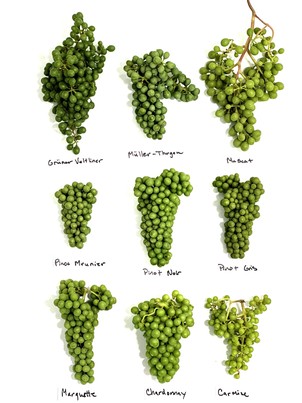
The Countdown Begins—Sparkling Harvest Awaits
At Kramer Vineyards, the excitement is palpable as we approach the sparkling harvest, set to commence after Labor Day. Our vineyards are lush with promise, each grape variety reaching its pinnacle of perfection. With the delicate flavors and effervescence they embody, these grapes will soon be carefully hand-picked to become the heart of our exquisite celebratory wines.
The sparkling harvest holds a special place in our winemaking calendar, as the ripeness benchmarks for this style differ from other wines. We seek grapes with less sugar, vibrant acidity, and delicately developed flavors, ensuring our sparkling wines boast the perfect balance of brightness and finesse.
As we count down the days to this effervescent spectacle, our team is meticulously preparing to capture the essence of the harvest and craft unforgettable sparkling wines that will delight your senses. Stay tuned for more insights into our vibrant journey as we approach this exhilarating season of winemaking artistry.
Embracing the Pinot Noir Harvest—An Autumn Symphony
As September unfolds, our focus shifts to the crown jewel of the harvest—the Pinot Noir. The soul of our winery, these grapes carry the stories of our vineyards and the spirit of the Yamhill-Carlton AVA. As the sun gently kisses the clusters, we prepare for the labor of love that lies ahead. The Pinot Noir harvest, scheduled to begin around September 30, is a symphony of flavors waiting to be composed.
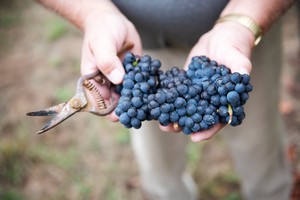
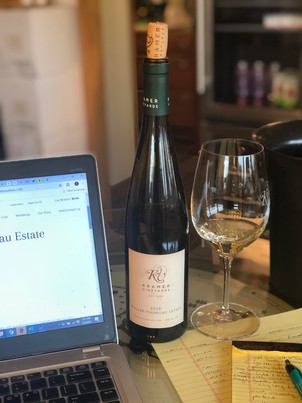
Crafting the Harvest Plan—A Testament to Tradition
At Kramer Vineyards, the eagerly awaited harvest season is not merely a seasonal event but a living testament to the rich traditions we hold dear. As we approach this momentous time, our winemaking team draws upon decades of experience and expertise to meticulously fine-tune our harvest plan.
Every detail is considered, from the timing of the pick to the precise handling of each cluster, as we navigate the art and science of winemaking. This carefully crafted plan is our guiding light, ensuring that no aspect is overlooked and every grape is treated with the utmost care and respect.
Behind the scenes, our dedicated team works tirelessly, fueled by passion and a deep connection to the land. The vineyards are abuzz with energy and anticipation as we prepare to capture the essence of the harvest and transform these remarkable grapes into extraordinary wines.
Throughout the generations, we have held true to our traditions, honoring the land and the vines that have flourished under our stewardship. Our harvest plan bridges past and present, embodying the wisdom passed down through time while embracing the innovation and vision that will shape the wines of the future.
As we embark on this vibrant journey, we invite you to join us in celebrating the spirit of tradition and craftsmanship that goes into every bottle of Kramer Vineyards wine. Together, we raise our glasses to the harvest season—an extraordinary time connecting us to the heart of winemaking artistry.
Teamwork in Action—A Symphony of Talent
Preparing for harvest is a celebration of unity as our team comes together with shared purpose and dedication. From vineyard to cellar, the spirit of teamwork resonates through every task. Each hand plays a part in nurturing the vines, selecting the perfect clusters, and preserving the grapes' essence through the winemaking process. Together, we craft wines that embody the heart and soul of Kramer Vineyards.
As the days grow shorter and the leaves take on their autumn hues, we stand at the threshold of a transformative journey. The harvest season at Kramer Vineyards is a vibrant ode to nature, tradition, and human ingenuity. From the sparkling harvest to the cherished Pinot Noir, each grape tells a story of the land, the people, and the magic that lies within every bottle. Join us on this extraordinary journey as we prepare to embrace the harvest with open arms and hearts filled with passion. The adventure awaits, and we invite you to share in the splendor of harvest at Kramer Vineyards. Cheers to the beauty of this coming season!
Share this post:
Pinot Noir’s Lighter Color and Body: The Art and Science Behind Oregon’s Iconic Wine
Understanding Pinot Noir’s Lighter Color and Body: From Vineyard to Cellar
At Kramer Vineyards, our passion lies in creating Pinot Noir that reflects the delicate balance of science and artistry. With its lighter color and elegant body, Pinot Noir is one of the most captivating wines, embodying the unique terroir of Oregon’s Willamette Valley. Let’s explore the fascinating factors—from the vineyard to the cellar—that make Pinot Noir so distinctive.
1. Why Pinot Noir Has a Lighter Color
Thin Skins and Anthocyanins
Pinot Noir’s signature light color can be attributed to its naturally thin grape skins, which contain lower levels of anthocyanins—the pigments responsible for red wine's hue. This delicate skin also impacts the wine’s body, giving it an elegant, nuanced character that sets it apart from fuller-bodied reds.
2. The Influence of Cool Climates and Terroir
The Willamette Valley’s cool climate plays a pivotal role in shaping Pinot Noir’s flavor and structure. Slow ripening allows the grapes to retain their natural acidity, resulting in vibrant flavors and a lighter body. Our vineyard’s ancient marine sedimentary soils, with their excellent drainage and rich minerality, add depth and complexity to every bottle.
3. Winemaking Techniques at Kramer Vineyards
Pump-Overs (Remontage)
In the first third of fermentation, we use pump-overs to gently circulate the juice over the grape skins. This method enhances flavor and color extraction while preserving the wine’s delicate balance.
Rack-and-Return (Délestage)
As fermentation progresses, we transition to rack-and-return techniques, pausing pump-overs entirely. Délestage involves draining the fermenting juice and returning it over the cap of skins, which softens tannins, refines the texture, and enhances integration.
Punch-Downs (Pigeage by Hand)
When the cap softens enough to punch to the bottom, we focus on hand punch-downs to delicately extract tannins and flavors. Guided by intuition and experience, we monitor the cap’s texture to determine the perfect pressing time, ensuring every vintage reaches its full potential.
Aging in French Oak
After fermentation, our Pinot Noir is aged in French oak barrels, with up to 25% new oak, to integrate subtle flavors of spice and vanilla without overpowering the fruit. This careful balance enhances the wine’s complexity and structure while preserving the essence of our terroir.
4. The Art and Science of Pinot Noir
Crafting Pinot Noir is as much an art as it is a science. At Kramer Vineyards, every decision—from fermentation techniques to barrel selection—is made with precision and care to honor the beauty of this exceptional varietal.
Join Us on the Pinot Noir Journey
Discover the science and artistry behind Kramer Vineyards' Pinot Noir. Visit our Tasting Room for private tastings and tours, or join our Wine Club to enjoy exclusive access to our wines.
The Art of Sparkling Wine: Storage, Opening, Serving, and Stemware - Kramer Style!
Mastering the Art of Oregon Sparkling Wine
Welcome to the world of Oregon sparkling wine, where proper storage, opening, serving, and stemware selection are key to preserving the integrity and enhancing the experience of each effervescent sip. At Kramer Vineyards in the north Willamette Valley, we take great pride in sharing our expertise on these essential aspects. Join us as we unlock the secrets of Kramer Vineyard's sparkling wines and discover the unique character that Oregon brings to the world of bubbles. In this blog post, we'll explore the art of storage, graceful bottle opening, impeccable serving techniques, and stemware that elevates the enjoyment of our Oregon sparkling creations.
Proper Storage: Nurturing the Effervescence of Oregon's Sparkling Wines
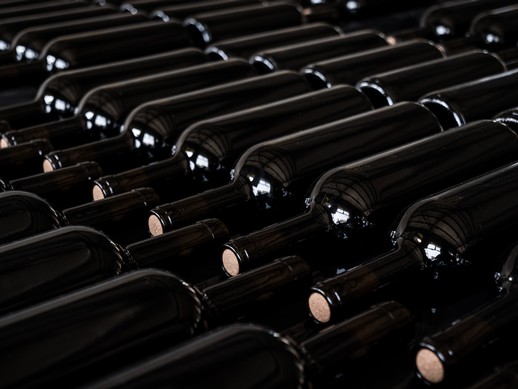
Creating the Ideal Environment
To properly store your bottles of Oregon sparkling wine, creating an ideal environment that allows them to age gracefully and preserve their vibrant flavors is crucial. Consider the following factors:
- Temperature and Humidity Control: For long-term storage, maintain a consistent and cool temperature between 45°F (7°C) and 55°F (13°C) to prevent fluctuations that could affect the wine's flavor and effervescence. Aim for a humidity level between 50% and 80% to avoid cork drying or excessive moisture.
- Minimizing Light Exposure: Protect your bottles from UV light, which can cause undesirable flavors. Store them in a dark or dimly lit area, such as a wine cellar or a cabinet with opaque doors.
- Allowing Bubbles to Evolve and Mature: Store the bottles horizontally to keep the cork moist and prevent it from drying out. This position ensures a proper seal and preserves the wine's effervescence as the bubbles gradually evolve, adding complexity to the wine over time.
Graceful Bottle Opening: Celebrating Oregon's Sparkling Wine
Mastering the Technique of Opening Sparkling Wine
Opening a bottle of Oregon sparkling wine is an art that adds to the anticipation and enjoyment of the moment. Follow these steps to open your sparkling wine like a pro:
- Remove the foil or wire cage gently, keeping your thumb on top of the cork.
- Wrap a tea towel around the cork and the top of the bottle to better grip and prevent the cork from flying unexpectedly.
- Hold the bottle at a slight angle, pointing away from yourself and others.
- Firmly grip the towel-covered cork and twist the bottle (not the cork) to gradually release the pressure, creating a soft and elegant pop.
By incorporating the tea towel, you can enhance your grip on the bottle, especially if it has become slippery due to being in an ice bath or condensation. This extra precaution ensures a controlled and safe opening, allowing you to enjoy the experience of opening an Oregon sparkling wine bottle.
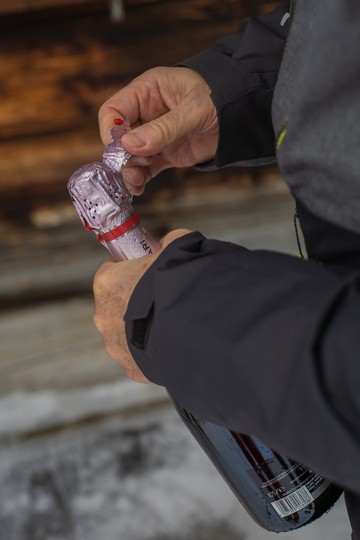
Unveiling Unique Character
As the cork is released, the aromas and flavors of our Oregon sparkling wine come to life. Take a moment to appreciate the effervescent bubbles dancing in the glass, indicating the wine's exceptional quality. The initial burst of bubbles reveals the wine's freshness and liveliness, creating a captivating visual display.
Just like still wines, sparkling wines transform as they warm slightly and have some air contact in the glass. This evolution can be a fascinating journey as the wine's aromas and flavors develop and unfold.
Savor each sip and allow the wine to evolve in the glass. Notice how the aromas become more pronounced, the flavors more nuanced, and the texture more expressive. Initially energetic and effervescent, the bubbles may mellow slightly over time, revealing a more delicate and refined effervescence.
Each glass offers a unique glimpse into the wine's character, showcasing the meticulous craftsmanship and the distinct terroir of Kramer Vineyard. Embrace the evolving nature of the wine as it warms and breathes in the glass, allowing it to reveal its true depth and complexity.
By taking the time to appreciate the wine's evolution in the glass, you can fully immerse yourself in the captivating experience of our Oregon sparkling wines and discover the intricate layers that make them truly special.
Impeccable Serving Techniques: Enhancing the Oregon Sparkling Experience
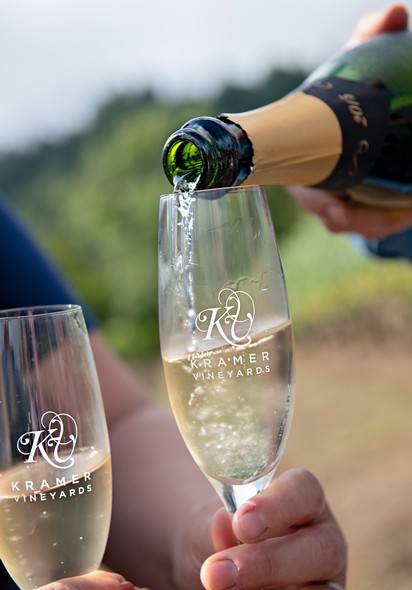
Finding the Ideal Serving Temperature
Serving our Oregon sparkling wines at the right temperature is crucial to fully appreciating their flavors, aromas, and effervescence. Ensuring the bottle is chilled to the optimal temperature can enhance the tasting experience and unlock the wine's true potential.
To bring out the best in most sparkling wines, we recommend serving them at a temperature between 41°F (5°C) and 45°F (7°C). This range helps preserve the bottle's effervescence and showcases the wine's fresh citrus notes and lively acidity. It's a great serving temperature that allows the wine to express its vibrant character.
For vintage Champagnes and extended tirage sparkling wines, you can slightly adjust the serving temperature to around 45°F to 50°F (7°C to 10°C). This subtle increase in temperature can enhance the development of toast and biscuit notes, adding complexity to these special wines.
While it's important to consider these recommendations, serving temperature is a personal preference, and you may find slight variations that suit your taste. The key is to avoid over-chilling, as excessively low temperatures can diminish the flavors and nuances of the wine. If your bottle feels too cold, allow it to rest at room temperature for a few minutes to gently warm up before serving.
By serving our Oregon sparkling wines at the recommended temperatures, you can fully appreciate their vibrant flavors, delightful aromas, and effervescent charm, ensuring a gratifying and memorable tasting experience.
Selecting Appropriate Stemware
The selection of stemware for sparkling wines is highly personal and often sentimental. Our recommendations aim to enhance the enjoyment of our Oregon sparkling wines, but ultimately, you should use the stemware that brings you the most joy, whether it be a coupe, flute, glass, or tumbler. The shape of the glass can influence the release of aromas, the display of bubbles, and the overall tasting experience. Here are some recommendations for different types of sparkling wines:
- For Pét-Nat & Celebrate wines, Prosecco, or Sekt: Flute
We recommend using flute glasses for our Celebrate and sparkling wines like Prosecco or Sekt. The slender and narrow flute shape helps maintain the effervescence and makes the bubbles last longer. It also creates an elegant and visually captivating experience, perfect for celebrating special moments. - For Traditional sparkling wines: Flute or Riedel Oregon Pinot Glass
For our traditional method sparkling wines, you have a couple of options. Flute glasses, with their slender shape, can preserve the effervescence and showcase the wine's lively bubbles. Alternatively, you can also use the Riedel Oregon Pinot Noir glass with a larger bowl. The broader bowl of this glass allows the bubbles to unfurl and develop, providing more space for the wine's aromas to evolve. - Vintage champagnes or extended tirage sparkling wines: Riedel Champagne glasses or the Riedel Oregon Pinot Glass
It's best to use glasses that can fully express their complexity for special wines like vintage champagnes or extended tirage sparkling wines. Riedel Champagne glasses, designed specifically for sparkling wines, provide the perfect shape to capture the wine's aromas and allow them to develop. Alternatively, you can also use the Riedel Oregon Pinot Noir glass, which offers a larger bowl to enhance the wine's aromatics and the expression of its unique character.
Choosing the right stemware enhances the visual appeal and allows you to fully experience our Oregon sparkling wines' aromas, flavors, and effervescence. Enjoy the captivating dance of bubbles and savor every sip in the glass that complements your chosen wine.
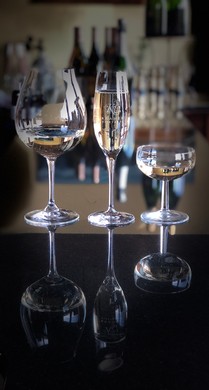
The Gentle Pour
A gentle and steady approach preserves the effervescence when pouring our Oregon sparkling wines. Tilt the glass at a slight angle and pour the wine slowly down the side of the glass, allowing it to cascade gently. This technique minimizes agitation, preserving the bubbles and preventing excessive foaming. When finished serving, seal the bottle with a sparkling stopper to hold the pressure for your next glass.
In the picturesque Willamette Valley, Kramer Vineyards proudly crafts exquisite Oregon sparkling wines that captivate the senses and reflect the region's unique terroir. By mastering the art of storage, opening, serving, and selecting the right stemware, you can unlock the full potential of our Méthode Champenoise creations. Ready to embark on your sparkling wine journey with Kramer Vineyards? Explore our exquisite selection of Oregon sparkling wines and experience the magic of bubbles in every sip. Visit our sparkling wine collection to discover our wines' exceptional craftsmanship and unique character. Cheers to living your best sparkling life the Kramer way!
Share this post:
Unleash the Flavors: Perfect Wine Pairings to Elevate Your Barbecue
Grilling and Wine Pairing Tips with Becky Kramer
Get ready for grilling and cookout season with a selection of wines to enhance your summer entertaining. Who better to offer expert advice on wine pairings than Becky Kramer, the Winery Director of Kramer Vineyards and a seasoned grilling enthusiast? Let Becky guide you through her top picks for selecting wines that will take your barbecue experience to the next level.
The Versatility of Dry Rosé: The Ultimate Goes-With-Everything Wine
Elevate your barbecue with the versatile pairing power of dry rosé. This refreshing wine effortlessly enhances the flavors of succulent shellfish, juicy ribs, classic sausages, and more. Sip chilled rosé as the aroma of sizzling grills fills the air, intensifying the pleasure of every bite. Its bright acidity and fruity notes create a match made in barbecue heaven.
“Always have plenty of chilled sparkling wine and rosé on hand. They’re some of the most food-friendly wines out there! The combination of refreshing, bright acidity and fruity flavors really works with the savory smokiness of the grill. A dry rosé can pair with everything from shellfish to pulled pork sliders, ribs, burgers, and sausages—even the potato salad.”
From perfectly grilled burgers to savory sausages, dry rosé adds a delightful touch to charred flavors, turning each mouthful into pure bliss. Even classic barbecue side dishes like potato salad find a worthy companion in this wine, as its refreshing acidity cuts through the creaminess, adding elegance and brightness. And yes, even hot dogs—the iconic barbecue staple—find their perfect match in dry rosé, balancing their richness with vibrant flavors.
Stock up on dry rosé for your next grilling session and experience the perfect harmony of flavors. Let this versatile wine transform your barbecue season into a culinary adventure, creating unforgettable moments around the grill.
Oregon Pinot Noir: A Grilling Delight
“Oregon Pinot Noir is quite versatile with grilled foods too,” she notes, “it’s inherently earthy and smoky, often spicy, and the red or dark fruitiness pops nicely without dominating the meal.”
The Willamette Valley is synonymous with Pinot Noir, and Kramer has plenty of experience pairing this with salmon, pork chops, lamb, chicken, and game birds. This exceptional wine's earthy and smoky undertones blend seamlessly with the richness of pork chops, the succulence of lamb, the juiciness of chicken, and the wild allure of game birds. With every sip, the spicy and red or dark fruitiness of the Pinot Noir bursts forth, enveloping your senses and enhancing the smoky essence of your grilled creations. Elevate your grilling prowess and ignite a symphony of flavors with the enchanting Oregon Pinot Noir, taking your barbecue gatherings to extraordinary heights.
Robust Reds for Bold Flavors
“If beef is on the menu, Becky will open something darker, like a Syrah or Rhône blend. Beef usually needs wines with more tannins, so reach for something that will stain your teeth.”
For beef enthusiasts, Syrah, Rhône blends, and Carmine are the go-to wines. With their robust flavors and bold tannins, these wines elevate the taste of grilled beef, burgers, lamb, and steaks. Sip on Syrah as you enjoy spareribs, barbecued chicken, grilled meats, hamburgers, lamb burgers, mushroom burgers, ribs with barbecue sauce, grilled sausages, and pepper-rubbed steak. Meanwhile, Carmine perfectly complements grilled beef, burgers, lamb, and rib-eye steak. Unleash your inner grill master and let these wines enhance the richness and smokiness of your beef creations for an unforgettable barbecue experience. These wines are the perfect partners for your grilled creations, leaving a lasting impression with every bite.
Müller-Thurgau: Perfect for Spicy Fare
“There’s something incredibly satisfying about standing over the grill with tongs in one hand and a glass of wine in the other.”
Embark on a fiery culinary adventure with Müller-Thurgau, the perfect pairing for your spicy barbecue creations. Its crisp acidity cuts through the heat, refreshing your palate while harmonizing with the spices. Müller's aromatic profile beautifully balances intense flavors, creating a delightful symphony on your palate. Experience the magic as each sip reveals new complexities, accentuating the vibrant nature of your spicy fare. Let Müller-Thurgau elevate your barbecue with elegance and zest, adding sophistication to your flavor-packed creations. Indulge in spice-rubbed ribs, barbecued chicken, or any fiery dish and discover the spice-pairing power of Müller-Thurgau.
“We have a hill that overlooks the vineyard and is our favorite spot to grill with friends. In the summertime, we’ll host casual cookouts and everyone brings good sides and wine to share while the meat or fish is cooking. It’s a wonderful communal experience in a relaxed atmosphere, and the view is amazing.”
We hope Becky's expertise and passion for grilling inspire you this barbecue season. At Kramer Vineyards, we take pride in crafting wines that beautifully complement a variety of culinary creations. Whether you're grilling drumsticks, savoring the communal joy of a cookout, or indulging in spice-rubbed ribs, our wines enhance your experience.
Join Becky in her love for grilling and wine by exploring our exceptional selection of grill-friendly wines. Indulge in the refreshing and versatile dry rosé, embrace the bold flavors with our Oregon Pinot Noir and robust reds, and unleash the spice-pairing power of Müller-Thurgau. Let our wines take you on a culinary journey with each sip, creating unforgettable moments around the grill. Explore the exceptional offerings from Kramer Vineyards and create lasting memories around the fire. Cheers to delicious food, joyful moments, and the perfect wines to accompany them.
Shop Sparkling Wines | Shop White Wines & Rosé | Shop Red Wines
The Other 4%: Exploring Unique Oregon Wine Varietals at Kramer Vineyards
Did you know that 96% of the vineyard acreage in the Willamette Valley is dedicated to Pinot Noir, Pinot Gris, and Chardonnay? While these noble varieties have captured the spotlight, an exciting world of alternative Oregon wine varietals is waiting to be explored. At Kramer Vineyards, we invite you to venture beyond the familiar and discover "The Other 4%."
The Alternative Varietals at Kramer Vineyards
While Pinot Noir, Pinot Gris, and Chardonnay may be the stars of the Willamette Valley, we have been passionate about cultivating lesser-known varietals that thrive in our unique terroir. Let's dive into the intriguing characteristics of Grüner Veltliner, Müller-Thurgau, Pinot Meunier, Carmine, and Marquette.
Müller-Thurgau: A Hidden Gem
Müller-Thurgau, a relatively unknown varietal, has found a thriving home in our vineyards since the mid-1980s. Its story at Kramer Vineyards began when owner Keith Kramer took a vineyard management class in the early 1980s. During the class, he encountered a fellow enthusiast who couldn't contain their excitement about Müller-Thurgau for Oregon. Intrigued by the fervor, Keith decided to explore this grape further.
"We bought some when we had the opportunity in the mid-80s," Keith recalls. The wine made from Müller-Thurgau grapes was a hit, prompting us to plant vines at our estate. This varietal proved exceptionally productive at our site, consistently yielding flavorful fruit even in the most challenging vintages.
Since then, we've crafted various Müller-Thurgau wines, from dry to off-dry, semi-sweet to dessert, and even sparkling. Our sparkling and still wines have garnered popularity and often rank as the top sellers in our tasting room. In 2018, Wine Enthusiast recognized us as a Notable Müller-Thurgau Producer in the US, further validating our dedication to this exceptional varietal.
Indulge in the enticing flavors of peach, starfruit, lychee, passionfruit, mango, lime, gooseberry, and sweet basil that define our Müller-Thurgau wines. Experience the charm of this hidden gem and join us in celebrating the recognition and acclaim our Müller-Thurgau wines have garnered.
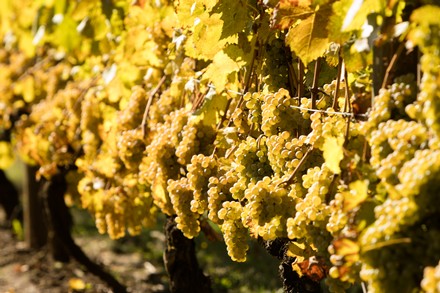
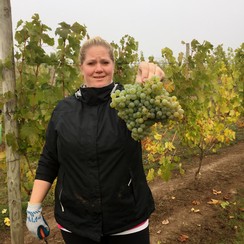
Grüner Veltliner: A Crisp and Versatile White
Grown on our estate since 2010, Grüner Veltliner is a remarkable white grape variety known for its crispness and expressive flavors. This Austrian favorite captivates with notes of lemon, lime, cucumber, peach, white flowers, freshly cut grass, green apple, and pear. Its high acidity and versatility make it an excellent choice for food pairing, complementing a range of dishes.
At Kramer Vineyards, we've taken the allure of Grüner Veltliner a step further by crafting a spectacular sparkling wine. The lively effervescence and elegant flavors of our Grüner Veltliner sparkling wine delight the senses. With each sip, you'll experience the vibrancy of citrus, the complexity of orchard fruits, and the refreshing zing that only sparkling wines can deliver.
Whether you savor our still Grüner Veltliner or indulge in the sparkling variation, this exceptional varietal will captivate your palate and elevate your wine experience. Join us in celebrating the versatility and sparkling brilliance of Grüner Veltliner at Kramer Vineyards.
Pinot Meunier: A Sparkling Delight
Pinot Meunier is an exceptional grape variety in our vineyards, exclusively planted, grown, and harvested for our traditional sparkling wine program. This distinctive grape adds depth and character to our sparkling wines, contributing to their unique and effervescent charm. Indulge in the enchanting flavors of cherries, blackcurrants, blackberries, tobacco, leather, and subtle spice that define our Pinot Meunier sparkling wines. With every sip, experience the artistry and dedication that goes into crafting these sparkling delights at Kramer Vineyards.
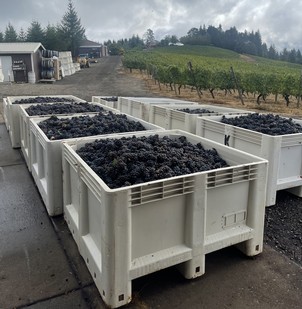
Carmine: A Heritage from California
Carmine has a fascinating history that traces back to its creation in 1946 at UC Davis by Dr. Harold Olmo. This unique grape variety is a cross of Cabernet Sauvignon, Carignan, and Merlot, developed specifically to thrive in California's cooler, coastal regions. Although Olmo's vision for Carmine did not gain widespread popularity as intended, the vines found their way north to Oregon in the 1970s, landing at Courting Hill Vineyard in Banks. It was there that Keith Kramer, inspired by the Oregon wine legend Jim Leyden, was introduced to this intriguing grape variety. In 1989, Leyden generously gifted Kramer Vineyards with our first Carmine vines.
At Kramer Vineyards, we have dedicated ourselves to unlocking the potential of Carmine. This late-ripening, thick-skinned grape has revealed its true character through our continuous exploration in the vineyard and the winery. Our Carmine wines, known for their dark red color, exude herbaceous aromas and peppery notes. With influences from its Cabernet Sauvignon grandparent, you can expect dark fruit flavors, dark chocolate, and an occasional hint of mint. Indulge in the distinctive flavor profile of our Carmine wines, featuring dried cranberries, maraschino cherries, cinnamon, anise, bell pepper, and cracked peppercorns.
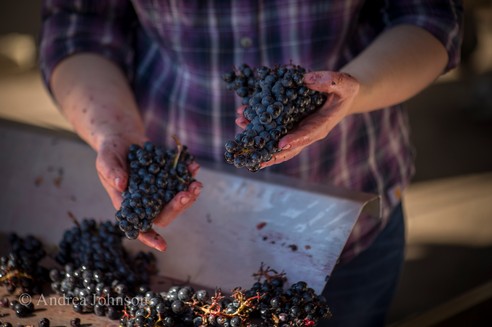
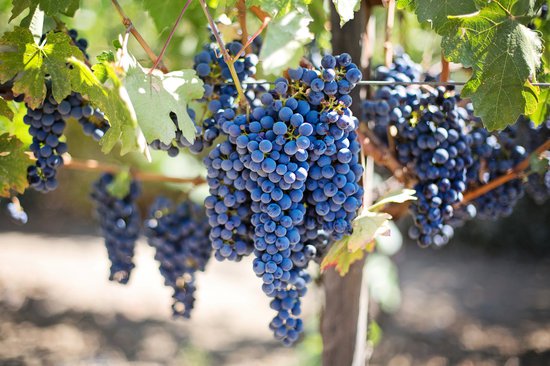
Marquette: A Challenging Yet Essential Grape
Marquette, a captivating grape variety, was planted in our vineyard in 2010 across 0.5 acres. Developed by the University of Minnesota for extremely cold climates, Marquette is not well suited to our region or our property. Its intended growing conditions are much cooler than what we have in the Willamette Valley, resulting in unique challenges for its cultivation.
One of the major obstacles we face with Marquette is its early ripening nature. The vines tend to bloom weeks ahead of other varietals, often coinciding with rain, interfering with fruit set. This presents a constant battle to ensure proper fruit development during critical growth periods.
Another challenge arises at harvest time. Due to its early ripening, Marquette is susceptible to bird predation. The birds sometimes devour the fruit before we can pick it. Additionally, the chemistry of Marquette at ripeness is unusual, often exhibiting high sugar levels and acidity, requiring careful monitoring and timing for optimal harvest.
While we wouldn't recommend planting Marquette in the Willamette Valley, we have found a wonderful use for this challenging grape. By cofermenting it with grapes sourced from throughout our estate vineyard, we create the delightful summery red wine called 27 Blocks. This cofermentation allows Marquette to shine as a base, contributing its unique character to the blend.
With its flavor profile encompassing cherries, blackcurrants, blackberries, tobacco, and leather, 27 Blocks is a captivating expression of the harmonious interplay between our vineyard's nine grape varieties. Despite the challenges of growing Marquette in our region, its contribution to creating 27 Blocks makes it an essential part of our winemaking journey.
As you explore the wonders of Oregon wine, don't limit yourself to the familiar. At Kramer Vineyards, we invite you to journey into "The Other 4%" and discover the exceptional varietals that make our region unique. From the crispness of Grüner Veltliner to the hidden gem of Müller-Thurgau, the unique expressions of Pinot Meunier, and the innovative spirit of Carmine and Marquette, each varietal tells a story that deserves to be savored. Join us in exploring flavors and expanding your wine horizons with Kramer Vineyards.
Discover the Charm of Local Wineries: Finding the Perfect Winery Near You
Are you a wine enthusiast eager to support local wineries? Whether you're a seasoned connoisseur or new to the world of wine, embarking on an adventure to explore the best wineries in your neighborhood is a delightful journey. Local wineries are cropping up in unexpected places, offering unique wines that showcase the distinct flavors of your region. Not only does supporting these wineries boost the local economy, but it also allows you to savor and appreciate the diverse flavors that your community has to offer. Let's raise a glass and discover the best wineries near you!
The Benefits of Supporting Local Wineries
Supporting local wineries extends beyond enjoying a glass of wine. By visiting and purchasing from these wineries, you contribute to the growth of the local economy and help small businesses thrive. Many local wineries prioritize sustainability in their winemaking practices, making your support good for your taste buds and the environment.
Moreover, buying wine directly from the winery is the most sustainable choice as a consumer. You reduce the carbon footprint of distribution by eliminating the need to transport the wine to a shop or restaurant.
Additionally, supporting local wineries allows you to experience your region's unique flavors and characteristics. These wineries often use grapes specific to your area, producing truly distinctive wines. By tasting and learning about these wines, you can develop a deeper appreciation for the flavors and culture of your community.
When choosing a local winery to visit, consider factors such as the types of wines you enjoy. Research wineries that specialize in the wines you're interested in tasting. Additionally, consider the ambiance you prefer, whether casual or upscale, and explore wineries that align with your preferences. Location is also crucial, so research the wineries' proximity and surrounding amenities to plan your visit effectively.
Doing Your Homework: Tasting Room Details
Before visiting a winery's tasting room, it's helpful to research ahead of time. Here are key details to consider:
- Business Hours: Check the tasting room's operating hours to align with your visit plans.
- Reservations: Some wineries require reservations, especially during peak times. Check if a reservation is needed and make one if necessary to secure your spot.
- Tasting Fees: Find out if the winery charges a tasting fee and if it's refundable with a purchase. This information helps you plan your budget accordingly.
- Wine Varieties: Get a glimpse of the winery's wine offerings. Discover their signature wines and special releases worth exploring during your visit.
- Wine Prices: While specific prices may not be listed, learn if the winery offers wines at different prices. From affordable options to higher-end selections, there's something for every palate and budget.
- Larger Parties: If you plan to visit with a larger group, contact the winery to make arrangements and ensure a smooth and enjoyable experience.
- Food Options: Inquire if the tasting room serves food or allows visitors to bring their own. Some wineries offer food pairings or partner with local eateries, enhancing your tasting experience.
- Accessibility: We believe everyone should have access to exceptional wines. Check if the winery provides accessibility features like wheelchair ramps and accessible restrooms, ensuring a comfortable visit.
- Visitor Policy: Check if the tasting room is exclusively for guests of legal drinking age or if they allow kids and dogs. This information will help you plan accordingly and avoid surprises during your visit.
- Local Accommodations: Extend your winery experience by staying nearby. Explore suggested accommodations, such as hotels, bed and breakfasts, or vacation rentals, to make the most of your visit.
Sustainability in Winemaking
As people become more environmentally conscious, sustainability in winemaking has gained significance. Many local wineries are actively reducing their environmental footprint and implementing sustainable practices.
Some wineries have embraced sustainable, organic, or biodynamic farming methods, while others utilize renewable energy sources like solar panels to power their production facilities. By supporting these wineries, you enjoy delicious wines and contribute to a more sustainable future.
Conclusion and Call to Action to Support Local Wineries
Exploring the best wineries in your neighborhood is a fun and exciting way to support local businesses while discovering new flavors and experiences. By visiting local wineries, you enjoy delicious wine, support the local economy, preserve tradition, promote sustainability, and reduce carbon emissions.
Five Fizzy Facts About our Celebrate Bubbly
Are you a fan of sparkling wines? If so, you're in luck because Kramer Vineyards produces some of the best Oregon sparkling wines! Here are five fizzy facts that make our wines stand out:
The Kramer estate vineyard.
100% varietal wines
Our Celebrate sparkling wines are unique varietal wines, including Pinot Noir, Grüner Veltliner, Pinot Gris, and Müller-Thurgau. We believe that each grape's flavor is best showcased on its own. The effervescence of our Celebrate wines only enhances the natural flavors and aromas of these varietals, resulting in a refreshing and perfect sparkling wine for any occasion.
Handcrafted in small batches
Due to the size of our vineyard and winery, we've always taken a small-batch approach to winemaking. With only 22 acres of estate vines and 27 individual blocks, we carefully track and evaluate each block to ensure the fruit is of the highest quality for wines of this style. This approach means we're always working with tiny lots, allowing us to pay close attention to each batch and ensure that our wines are of the highest quality.
Fresh and lively
Our Celebrate sparkling wines are not aged for extended periods like traditional method sparkling wines. Instead, we use a modern proprietary method to release the wines only a few months after harvest. This preserves the fresh, lively character of the grapes and results in a wine bursting with flavor.
Tiny bubbles
Most force-carbonated sparkling wines are injected with carbon dioxide on the bottling line, producing coarse, soda-pop-like bubbles. We believed a smaller bubble was possible with force carbonation. In 2004, owner Keith Kramer developed the system we use today. A week before bottling, the wine is transferred into a custom-built tank for pressurization. We chill the wine while gradually raising the pressure, resulting in tiny, plentiful bubbles. Our Celebrate sparkling wines are unique, high quality, and available at a lower price point than traditional sparkling wines due to the abbreviated aging process.
Sustainable winemaking
We prioritize sustainable winemaking practices to minimize our environmental impact at Kramer Vineyards. Our vineyard is dry-farmed, meaning we rely solely on natural rainfall to irrigate our vines, reducing water usage. Additionally, we use a lighter glass bottle for our Celebrate sparkling wines, which has a lower carbon footprint than traditionally made sparkling wines. From using solar panels to power our winery to implementing water conservation techniques, we're committed to preserving the beautiful Oregon wine country for generations.
Kramer Vineyards produces some of the finest Oregon sparkling wines, and we're proud to share them with you. From our 100% varietal wines to our small-batch, handcrafted approach to winemaking, we strive to create wines of exceptional quality and character. We invite you to visit our tasting room and experience our sparkling wines for yourself. Our knowledgeable staff will guide you through a tasting and share our passion for sustainable winemaking. Take advantage of this opportunity to discover some of the best sparkling wines in Oregon. Come and see us today!
Celebrate Rosé of Pinot Noir
A Beginner's Guide to Pinot Noir Clones: Q&A with Kramer Vineyards
These vines have the same DNA
What is a clone?
Pinot Noir clones are genetically identical vines propagated asexually from a "mother vine." In other words, they are vine cuttings taken from a single, original vine and grown to produce new vines. These new vines are identical to the mother vine and to one another, which allows winemakers to plant vineyards with consistent grape quality and characteristics. Pinot Noir clones can vary in their susceptibility to disease, tolerance of climatic conditions, and flavor profiles. Understanding the different features of each clone is crucial for me, as I am always looking to produce wines of the highest quality that reflect the unique terroir of our vineyard.
How do new clones of Pinot Noir arise?
Pinot Noir clones can arise through spontaneous mutations in the grapevine's DNA. These mutations create genetic variations that can change the vine's physical characteristics, such as the size or shape of its leaves or clusters of grapes. Winemakers often select and propagate clones that exhibit desirable traits, such as resistance to disease, tolerance of climatic conditions, or unique flavor profiles.
Pinot Noir has been cultivated for thousands of years, which has allowed numerous mutations to occur and be identified. While most clones originate from France, unique clones have also been identified in Switzerland, California, Oregon, and other regions. The mapping of the Pinot Noir genome in 2007 has further expanded our understanding of the genetic makeup of this grape variety and the potential for discovering new clones in the future.
Pinot Noir clones are continually evolving, and new clones may arise from spontaneous mutations. There is a possibility that the Kramer Vineyards may have a unique clone of Pinot Noir that has yet to be identified. This potential for discovery is part of what makes working with Pinot Noir clones so exciting for us.
Jumping genes are present in almost all living cells. 50% of the human genome are jumping genes; up to 90% of the maize genome are jumping genes!
Is it difficult to detect differences between clones of Pinot Noir in wine tasting?
You don't have to be a wine expert to appreciate the impact of clones on the flavor and aroma of Pinot Noir. Pinot Gris and Pinot Blanc are also clones of Pinot Noir, created through mutations that affect the skin color of the grape. These mutations are so distinctive that they're often considered distinct grape varieties. We'll dive deeper into these varietals in another post. But for now, consider this: if you can tell the difference between white and red wine, your palate is expert enough to explore the nuances of Pinot Noir clones. By understanding the various clones, you can better appreciate the unique qualities of different Pinot Noir wines. For more on this topic, see Pinot Blanc and Pinot Noir Blanc: What's the Difference?
Why is it useful to know about Pinot Noir clones?
The answer for winegrowers and winemakers is simple: it allows us to choose the best clones for our specific growing conditions and wine style. For wine drinkers, knowing about clones can enhance your appreciation and understanding of the wine you're enjoying. At Kramer Vineyards, we grow nine clones of Pinot Noir and make single-clone wines from several different clones of Pinot Noir. Let's take a closer look at the characteristics of the main clones in our vineyard.
Pommard
The Pommard clone, originating from Pommard, a village in the Burgundy region of France, has made a new home in the Yamhill-Carlton AVA, where our Kramer Estate vineyard is located. It has been an essential part of Willamette Valley Pinot Noir's history and reputation, as it was one of the first clones available in the US. It is planted in many of the region's oldest vineyards, including at Kramer Estate. This clone produces medium-sized clusters, often with shoulders, and is well-suited to the cool, moist climate of the Willamette Valley.
At Kramer Vineyards, the Pommard clone was the first clone of Pinot Noir planted in 1984 and remains a significant component in many of our Pinot Noir wines, including our Estate, Cardiac Hill, Rebecca's Reserve, and Heritage Pinot Noir wines. The grapes of the Pommard clone produce balanced and elegant wines suitable for aging, which is why it is still an essential part of our vineyard. When people think of what Oregon Pinot Noir tastes like, the Pommard clone is often a big part of that reputation.
Dijon 115: The Finesse and Balance of Pinot Noir
Discover the allure of Dijon 115, a prized Pinot Noir clone hailing from Burgundy's University in Dijon. Recognized as part of the esteemed Dijon clones, Dijon 115 offers a captivating combination of early ripening, small berries bursting with intense flavors. Renowned for its finesse and balance, wines crafted from Dijon 115 grapes leave a lasting impression. At Kramer Vineyards, we were among the early adopters of this clone, planting it alongside Pommard in our esteemed Rebecca's Reserve block back in 1992. Today, Dijon 115 remains an integral component in our esteemed Cardiac Hill and Estate Pinot Noirs, showcasing its remarkable attributes year after year. Unlike other clones known for specific characteristics like spiciness or tannin, Dijon 115 stands apart as a complete wine, offering unparalleled balance and elegance. Our decision to embrace this clone was influenced by a renowned winemaker from Burgundy who attested to its surging popularity. Experience the magic of Dijon 115 and savor the harmonious symphony it brings to each glass.
Dijon 777: Embracing Richness and Spiciness
Originating from the prestigious University in Dijon, Burgundy, Dijon 777 is an early ripening clone that gives rise to small clusters and berries, culminating in wines of intense color and pronounced tannins. Notably characterized by a captivating spiciness, Dijon 777 has become a sought-after choice for blending. Our journey with this numbered clone began in 2001 when we first planted it at Kramer Estate, integrating it harmoniously into our distinguished Estate Pinot Noir. Owner and winegrower Keith Kramer holds a special affinity for the fiery allure of Dijon 777. In 2019, inspired by a neighboring block consistently producing exceptional fruit quality, he made the bold decision to graft 0.6 acres of Muller-Thurgau to Dijon 777, tripling its acreage. The result? A tribute to the clone's undeniable character and the promise of extraordinary wines to come. Join us on this spicy exploration and experience the distinct charm of Dijon 777 in every sip.
In conclusion, while clonal selection is essential in producing exceptional Pinot Noir, it is just one piece of the puzzle. The terroir and microclimate of a vineyard site can significantly impact how a particular clone expresses itself in the resulting wine. At Kramer Vineyards, we have seen this firsthand in our 22-acre vineyard. If you're interested in exploring the unique characteristics of each clone, we invite you to visit the single clone Pinot Noir section of our online store. Here you can experience each clone's distinct personality and flavors and gain a deeper appreciation for the complex interplay of factors that create truly exceptional wines.
Meet Piquette: Wine Just Got Cooler
Discover the Delights of Piquette: A Refreshing, Sustainable Alternative
Piquette is a unique and refreshing drink that offers a delightful alternative to traditional wines. Crafted from pressed grape skins, Piquette is a lower-alcohol, lightly sparkling beverage with a vibrant flavor profile. At Kramer Vineyards, we have embraced this age-old winemaking technique to create a fizzy and refreshing drink that showcases our commitment to sustainability and innovation.
Crafting Piquette: The Art of Repurposing Grape Skins
To create our Piquette, we repurpose the grape skins that remain after the juice extraction process. These grape skins are rehydrated, allowing the release of sugars and flavors. After steeping for four days, the mixture undergoes gentle pressing, resulting in a beautiful rosy hue. The must is then fermented in stainless steel tanks, creating the delightful effervescence that characterizes Piquette.
"I saw a creative challenge in capturing so many trends with Piquette. It is the intersection of rosé, sparkling, low sugar, lower alcohol, single-serving packaging—and it's adjacent to the cider, craft beer, and hard seltzer categories." said second-generation winemaker Kim Kramer.
Tasting Notes: A Symphony of Flavors
Our Piquette delights the palate with a harmonious blend of flavors. Experience the compelling notes of pomegranate, cran-raspberry, rhubarb, and tart apple, complemented by subtle hints of earth and spice. Each sip of Piquette is a refreshing and vibrant journey, offering a unique taste experience unlike traditional wines.
Enjoying Piquette: Versatile and Refreshing
Piquette is a versatile beverage that can be enjoyed in various ways. Serve it chilled for a refreshing pick-me-up, or mix it into your favorite spritzer or sangria recipes for a flavor twist. It pairs wonderfully with light, summery foods like seafood, salads, grilled vegetables, or light appetizers. With its lower alcohol content, Piquette is perfect for daytime events or as a lighter alternative to wine.
Join the Piquette Revival: Embrace Sustainability and Refreshment
Be part of the Piquette revival and experience the joy of this unique and sustainable beverage. Whether planning a picnic, a leisurely day outdoors, or a social gathering, Piquette is the perfect companion. Celebrate the essence of vineyard life with this refreshing and easy-to-drink option that captures the spirit of innovation and sustainability.
Experience Piquette at Kramer Vineyards
Kramer Vineyards invites you to explore the delights of Piquette. Join us in embracing this ancient winemaking practice, reimagined for modern tastes. Visit our vineyard and savor the vibrant flavors of Piquette. This refreshing beverage embodies our commitment to sustainability and craftsmanship.
Explore our sparkling collection, including Piquette --->>>
Note: To learn more about the emerging trend of lower-alcohol Piquette in Oregon, we recommend reading "Is lower-alcohol Piquette Oregon's next big wine craze?".
Kramer Vineyards: Crafting Unique and Refreshing Beverages Since 1990
Kramer Vineyards is a family-owned and operated winery in its second generation. For nearly 40 years, they have been growing grapes at their sustainably farmed vineyard in the Yamhill-Carlton AVA. Kramer specializes in producing cool climate white, red, and sparkling wines at their property in Gaston, 30 miles west of Portland.
